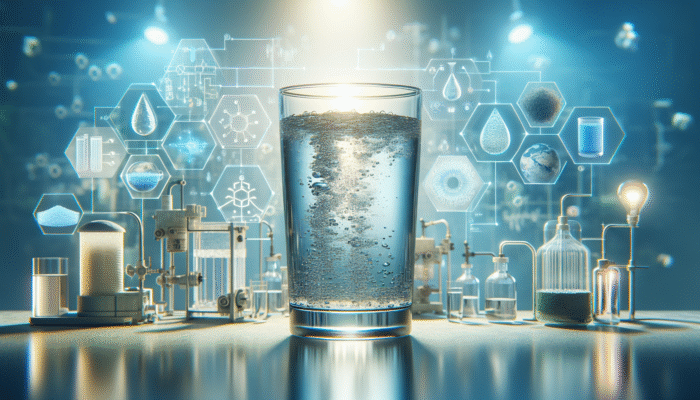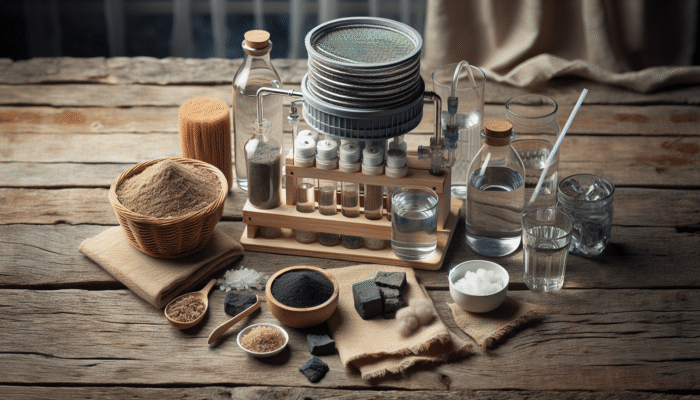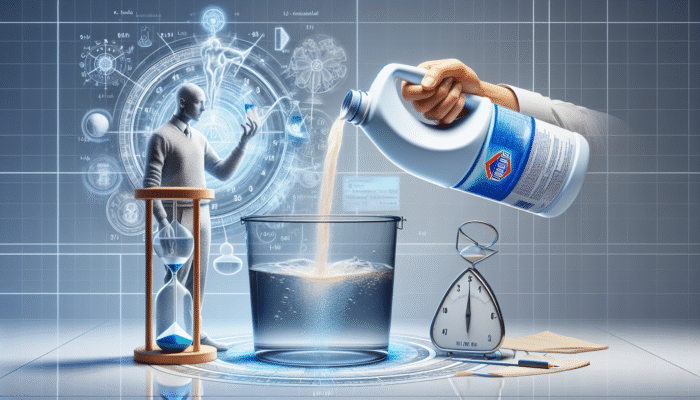Unlocking the Secrets of Effective Water Purification Techniques for Safe Drinking Water
Water purification is essential for sustaining life, yet billions globally lack access to clean and safe drinking water. The importance of homemade water purifiers cannot be overstated, as they offer reliable solutions during critical situations. By mastering the fundamental principles of water purification, you can create effective DIY solutions that ensure the water consumed by you and your family is safe and healthy. This knowledge empowers individuals to take charge of their water quality, which contributes to a healthier lifestyle and enhances overall well-being.
Diving Deep into Water Purification: Essential Concepts and Practical Techniques

Water purification encompasses a series of processes aimed at eliminating harmful contaminants from water, thereby making it safe for consumption and various everyday uses. This vital practice may incorporate a variety of physical, chemical, and biological techniques that work together to remove impurities and guarantee water safety. Understanding these processes is crucial for anyone eager to design their own homemade water purifiers. By becoming familiar with the basic principles of water purification, you can implement DIY solutions that effectively cleanse your water, ensuring it is both safe and potable for daily use.
To fully comprehend the concept of water purification, it’s essential to explore the different strategies available. Filtration, for instance, is an effective method that removes physical particles and microorganisms from water, while chemical treatments are employed to eradicate bacteria and viruses. The effectiveness of these methods often hinges on the specific contaminants present in the water source. For example, sediment filtration might suffice for larger particles, but additional methods may be necessary to tackle bacteria and harmful chemicals effectively, ensuring comprehensive water safety.
For those residing in areas with unreliable water sources, the capacity to construct a dependable homemade water purifier can be a matter of survival. Whether you are navigating remote terrains or dealing with the aftermath of a natural disaster, possessing the skills to purify water effectively ensures that you and your loved ones stay hydrated and healthy during challenging times. This knowledge is empowering, enabling individuals to take proactive steps in safeguarding their water quality.
Identifying Common Contaminants Found in Water Sources
Water sources may contain a variety of contaminants that pose significant health risks to consumers. Common offenders include bacteria, viruses, chemicals, and heavy metals. Understanding these contaminants is crucial for anyone designing their homemade water purifiers, as each type requires a tailored approach to ensure effective removal.
Bacteria and viruses represent some of the most pressing concerns regarding water safety. Pathogens like E. coli and Giardia can infiltrate water supplies, primarily due to fecal contamination. These microorganisms can result in a range of gastrointestinal illnesses and other severe health issues upon ingestion. Traditional purification methods, such as boiling water or using chlorine, can effectively eliminate these hazardous threats when applied correctly, thus safeguarding public health.
Chemical contaminants, including pesticides and heavy metals like lead and mercury, along with industrial pollutants, can drastically undermine the quality of drinking water. These substances often necessitate more advanced purification techniques, such as activated charcoal filtration, to achieve effective removal. Heavy metals are particularly concerning in urban environments, where industrial waste can taint local water supplies, making it imperative to address them adequately for the community's safety.
Ingeniously designed homemade water purification systems can confront these specific contaminants effectively. For instance, integrating activated charcoal into your system can assist in eliminating harmful chemicals, while employing proper filtration techniques can efficiently remove bacteria and viruses. By identifying these threats, individuals are better prepared to customise their purification processes and enhance the quality of the water they rely on for their daily needs.
The Critical Significance of Water Purification for Health and Well-Being
Access to clean water is fundamental for sustaining human health and overall well-being. The importance of water purification is particularly pronounced in regions contending with water scarcity or pollution issues. By utilising homemade water purifiers, individuals can proactively ensure their water safety without relying solely on commercial alternatives, which may be costly or not readily available.
In many parts of the world, especially in developing regions, securing clean drinking water remains a substantial challenge. According to the <a href="https://survivalbite.com/city-sanitation-solutions-a-comprehensive-approach/">World Health Organization</a>, over 2 billion people reside in countries experiencing high water stress. In such contexts, homemade water purifiers emerge as a cost-effective and accessible means of securing potable water for everyday use and survival, thereby enhancing health outcomes.
Moreover, DIY purification methods empower individuals by equipping them with essential knowledge and skills that can prove invaluable during emergencies. Whether faced with a natural disaster, a community crisis, or simply needing clean water while travelling, the ability to create effective purifiers can make a significant difference. By prioritising safety through personal initiative, individuals contribute to healthier communities and an overall improved quality of life.
Crucial Materials Required for Constructing Your Own Water Purifiers

Creating an effective homemade water purifier begins with a comprehensive understanding of the materials needed for construction. Selecting appropriate materials can significantly enhance the purification process, ensuring the production of safe drinking water. This section delves into natural filtration materials, commonly available household items that can be repurposed, and chemical purification agents that can assist in your water purification efforts.
Utilising Natural Filtration Materials for Optimal Purification Results
Natural filtration materials such as sand, charcoal, and gravel are essential components when constructing a highly effective homemade water purifier. These materials are often readily accessible and can be used in various combinations to achieve optimal purification results, making them perfect for DIY projects.
Sand serves as an efficient medium for removing larger particles from water, acting as the first line of defence in any filtration system. When arranged in layers appropriately, sand can trap sediments and debris, allowing cleaner water to flow through. Activated charcoal, in particular, is an incredibly powerful adsorbent that can effectively reduce chemicals, odours, and even impurities that cause discoloration in water. Combining sand and charcoal in your filtration setup can significantly enhance the effectiveness of the purification process.
Gravel plays a supportive role in the filtration system. By serving as a foundational layer beneath sand and charcoal, it helps maintain the structural integrity of the filter while allowing water to flow freely through. When constructing your homemade water purifier, the arrangement and proportion of these materials are crucial for ensuring maximum efficiency. A typical setup may involve gravel at the bottom, followed by a layer of sand, and topped with activated charcoal. This layered approach not only filters water physically but also facilitates chemical adsorption, providing a comprehensive purification process.
Repurposing Common Household Items to Enhance Filtration
Repurposing everyday household items can introduce an innovative dimension to your homemade water purifiers. Many commonplace materials can serve as effective filters, offering a sustainable alternative to commercial products while promoting environmental consciousness.
Cotton and cloth are excellent choices for initial filtration stages. They can function as a sieve to capture larger particles before the water passes through finer layers. Coffee filters can also effectively remove sediment and debris, making them an ideal choice for improving filtration. Utilising these materials not only reduces waste but also fosters innovative solutions in water purification.
Another inventive approach involves using plastic bottles. By cutting the bottom off a bottle and inverting it, you can create a funnel-like structure. Filling this makeshift filter with layers of sand, charcoal, and gravel creates a functional filtration system that efficiently produces cleaner water for drinking.
Employing these household items not only enhances your ability to create effective homemade water purifiers but also promotes sustainability through waste reduction. In an era where environmental awareness is increasingly important, leveraging materials you already possess can lead to significant positive outcomes in your water purification efforts.
Incorporating Chemical Purification Agents for Enhanced Water Safety

In emergency situations, certain chemical purification agents can prove vital for ensuring water safety. Understanding the appropriate application of substances like bleach and iodine can significantly enhance the effectiveness of homemade water purifiers.
Unscented household bleach can function as a powerful disinfection tool. When added to water in the correct proportions, it effectively kills bacteria, viruses, and parasites. However, it’s crucial to allow the treated water to sit for at least 30 minutes before consumption, ensuring that the bleach has had sufficient time to eliminate any pathogens present, thus safeguarding health.
Iodine represents another effective option, commonly found in water purification tablets. It can successfully eliminate harmful microorganisms within approximately 30 minutes. However, it’s essential to note that prolonged consumption of iodine-treated water may not be suitable for everyone, particularly pregnant women or individuals with thyroid conditions, requiring careful consideration during usage.
Integrating these chemical agents alongside your homemade water purifiers can add a significant layer of protection, especially when the source water is heavily contaminated. By understanding the correct application of these substances, you can substantially bolster your water purification efforts and ensure the water you consume is safe.
Employing Solar Water Disinfection: Harnessing Natural Energy for Effective Purification
Utilising the sun’s energy provides a simple, eco-friendly approach to water purification. Solar water disinfection (SODIS) is a method that employs UV radiation from sunlight to eradicate pathogens in water. Implementing this technique can have a profound impact in areas with limited resources, offering a sustainable solution for water safety.
The SODIS method requires clear, transparent plastic bottles filled with water. When exposed to direct sunlight for at least six hours, UV rays penetrate the water, effectively reducing the levels of harmful microorganisms and pathogens. This technique is particularly beneficial in tropical regions where sunlight is abundant and can be easily harnessed for water purification.
Another innovative strategy involves constructing solar stills. These devices can be made from simple materials, allowing you to capture evaporated water, which condenses on a cooler surface and drips into a clean container. This method not only purifies the water but also concentrates any salts or heavy metals present, providing an effective solution for various water sources.
Incorporating solar disinfection into your homemade water purifiers enhances the sustainability of your purification efforts while reducing dependency on chemical agents. Understanding how to leverage natural resources for water safety empowers individuals and communities globally, fostering a greater sense of self-reliance and environmental stewardship.
Step-by-Step Guide to Constructing Your Own Water Purifier
Building your homemade water purifier can be an immensely rewarding project, allowing you to tailor the purification process to suit your specific needs. This section provides detailed instructions on assembling various types of purifiers, empowering you to ensure safe drinking water effectively and efficiently.
Creating a Basic Sand and Charcoal Filter for Effective Purification
Constructing a sand and charcoal filter is a straightforward process that combines natural materials for efficient water purification. This DIY project requires minimal materials and can be accomplished using basic tools, making it accessible for most individuals seeking to ensure safe water access.
Start by gathering your materials: a clean plastic container, sand, gravel, activated charcoal, and some cloth or coffee filters. Begin by cutting the bottom off the plastic container. Place a layer of gravel at the very bottom to facilitate drainage and prevent clogging. Following this, add a layer of sand on top of the gravel, which will effectively filter out larger particles and sediments, ensuring that the water remains clear.
Next, it’s time to incorporate the activated charcoal. This potent adsorbent will capture chemicals and impurities suspended in the water, enhancing safety. Pour a thick layer of activated charcoal over the sand. Finally, cover the top with a cloth or a coffee filter to prevent debris from entering the filter system, ensuring a clean water output.
To use your newly constructed homemade water purifier, pour the water slowly through the opening. Collect the filtered water from the bottom, ensuring that it has passed through all layers of filtration. This simple yet effective filter can be a lifeline in regions with questionable water sources, providing safer drinking water for you and your loved ones.
Establishing an Effective Solar Water Disinfection System
Solar water disinfection (SODIS) systems offer an efficient and environmentally friendly method for purifying water using sunlight. Developing this approach requires minimal resources and technical knowledge, making it an accessible option for many individuals seeking to ensure safe drinking water.
Begin by gathering clear plastic bottles, ideally 1 or 2 litres in size. Fill each bottle with water, ensuring that some air space remains at the top. The water must be as clear as possible; cloudy water may reduce the effectiveness of the SODIS process. This step is crucial for achieving optimal disinfection results.
Once filled, place the bottles in direct sunlight, preferably on a reflective surface to enhance UV exposure. The bottles should be exposed to sunlight for at least six hours; however, longer exposure is advisable during overcast days to ensure all pathogens are effectively eliminated. After this duration, the water should be safe to drink, providing a sustainable solution for clean water access.
This method is particularly beneficial in regions with abundant sunlight. Not only does it effectively purify water, but it also encourages sustainable practices by harnessing renewable energy. The simplicity of homemade water purifiers, such as the SODIS system, empowers communities to take control of their water safety and enhance their overall health and well-being.
Assembling a Multi-Layer Filtration Unit for Advanced Water Purification
For those seeking a more sophisticated solution, assembling a multi-layer filtration unit can dramatically enhance water purification capabilities. This advanced system allows for the removal of a broader range of contaminants, ensuring higher water quality and safety for consumers.
Begin by acquiring multiple containers to serve as your filtration layers. Utilize the same materials as before: gravel, sand, and activated charcoal. Start by layering gravel at the bottom of one container, followed by a thick layer of sand, and lastly, a layer of activated charcoal to maximise filtration efficiency and ensure comprehensive purification.
Next, place another container beneath to collect the filtered water. As water flows through each layer, it undergoes multiple purification processes, significantly improving overall water quality. Ensure that each layer is sufficiently thick to provide effective filtration, allowing contaminants to be captured efficiently.
To further enhance the system's efficiency, consider adding additional materials such as crushed shells or coconut husks, which can provide specialised filtration to remove specific contaminants. By creating a highly effective homemade water purifier tailored to your unique needs, you can significantly improve your water quality and safety, ensuring peace of mind for you and your family.
Completing this advanced filter not only enhances your water quality but also serves as an educational project. Understanding the materials and processes involved in constructing a multi-layer filtration unit can empower individuals, particularly in communities with limited access to clean water, to take charge of their health.
Essential Maintenance and Safety Guidelines for Your Water Purifiers
Maintaining your homemade water purifiers is crucial for ensuring their effectiveness and longevity. Regular upkeep, adherence to safety precautions, and troubleshooting can significantly enhance your purification efforts and help maintain consistent water quality.
Implementing Regular Cleaning and Material Replacement for Optimal Performance
To ensure the durability and functionality of your homemade water purifiers, regular cleaning and material replacement are vital components of maintenance. Over time, filters can become clogged with contaminants, significantly reducing their effectiveness. Cleaning should be undertaken consistently, particularly if the filter is used frequently to guarantee optimal performance.
Start by disassembling your filter and rinsing the components with clean water. Gently scrub the inner surfaces to eliminate any residual contaminants. Pay special attention to the activated charcoal layer, as it can become saturated and lose its filtering capability over time, necessitating regular replacement to maintain effectiveness.
It is also advisable to replace the charcoal, sand, and gravel layers periodically, depending on usage levels. This renewal process is essential for maintaining optimal filtration capabilities. When replacing materials, ensure that all new components are clean and free from contaminants to avoid compromising the purification process.
Regular maintenance not only extends the lifespan of your homemade water purifiers but also guarantees that you consistently receive safe drinking water. Establishing a routine cleaning schedule can help you stay on top of necessary upkeep and ensure your systems are functioning as intended.
Following Safety Precautions During Operation to Protect Water Quality
When utilising homemade water purifiers, it is crucial to follow safety precautions to prevent contamination and ensure optimal system performance. Recognising potential risks associated with improper use can protect the quality of the water you consume, safeguarding health.
Always begin with clean water sources. While your filter may effectively remove contaminants, starting with polluted water can overwhelm the system and reduce its effectiveness. If possible, pre-filter heavily contaminated water through a cloth to reduce the load on your purification system before it is filtered.
After filtration, store the clean water in sanitised containers to prevent any risk of recontamination. Ensure that the storage vessels are free from residual chemicals or contaminants, which could compromise the purity of the filtered water. Being vigilant about cleanliness and hygiene during the purification process can significantly impact the quality of the water you receive, ensuring that your homemade water purifiers operate effectively and serve their intended purpose.
Troubleshooting Common Issues with Your Purification System for Enhanced Reliability
Even the most effective homemade water purifiers can encounter problems that may impede their functionality. Knowing how to troubleshoot common issues can help you maintain efficient water purification systems, ensuring consistent output quality.
If you notice that the water flow is significantly slower than usual, this could indicate that the filter is clogged. Cleaning or replacing the affected layers, especially if the charcoal or sand has become saturated, can often resolve this issue and restore functionality to your purification system.
Another frequent problem is the presence of an unusual taste or odour in the filtered water. This may signal that the activated charcoal is no longer effective and requires replacement. It is essential to monitor your filter’s performance regularly to identify these issues early, ensuring that your water remains safe for consumption and free from unpleasant characteristics.
Learning to identify and rectify common problems can enhance your experience with homemade water purifiers, allowing you to achieve the best possible results from your purification efforts and ensuring safe drinking water for you and your family.
Performing Scheduled Maintenance Checks on Your Purifiers for Longevity
Conducting scheduled maintenance checks on your homemade water purifiers is essential for ensuring that all components are functioning properly. Setting a regular inspection schedule can help you identify and address any problems before they escalate into significant issues, ensuring consistent water quality.
During maintenance checks, examine each layer of your filtration system for signs of wear and tear. Look for indications of clogging, discolouration, or any unusual odours that may suggest contamination. Regular assessments of the container’s integrity and any seals are also crucial in preventing leaks and ensuring the effectiveness of your purification system.
In addition to physical inspections, consider periodically testing the quality of the purified water. Simple at-home testing kits can help you verify that your purification system is effectively removing contaminants. These proactive steps will help you maintain a reliable source of clean drinking water, empowering you to depend on your homemade water purifiers with confidence.
Testing and Ensuring Water Quality for Safety and Peace of Mind
Ensuring the quality of your water is of utmost importance when utilising homemade water purifiers. This section will delve into simple testing methods to validate the effectiveness of your purification systems and advise when it may be necessary to seek professional assistance for comprehensive analysis.
Simple At-Home Methods for Testing Water Quality for Assurance
Testing your purified water at home is a straightforward process that can provide peace of mind regarding its safety and potability. Several simple methods can help you effectively assess the quality of your drinking water, ensuring that it meets safety standards.
One of the most accessible methods involves using test strips, which can detect the presence of various contaminants, including bacteria, chlorine, and pH levels. These strips provide instant results, helping you gauge the effectiveness of your homemade water purifiers in removing harmful substances and ensuring safety for consumption.
Another approach is conducting a simple jar test. Fill a clear jar with the filtered water and allow it to sit for a few hours. Observe the water for cloudiness, unusual odours, or sediment accumulation. If any of these signs are present, it may indicate that the purification process requires reassessment or modification to improve performance.
Regularly testing the water not only helps to ensure that your purification efforts are successful but also builds confidence in the safety of the drinking water you provide to your family and community, reinforcing the importance of water quality.
Understanding and Interpreting Test Results for Informed Decisions
Interpreting water test results is a critical skill that enables you to take appropriate action if contaminants are detected. Understanding the significance of different readings can inform your decisions regarding water safety and purification methods, ensuring the well-being of your household.
For example, if test strips indicate high levels of bacteria, it is essential to take immediate action, such as re-filtering the water or using chemical disinfectants to ensure safety. Similarly, if readings indicate excessive chlorine levels, you may need to adjust your filtration method or modify the materials used in your homemade water purifiers to enhance performance and ensure clean drinking water.
Understanding pH levels is also vital for water safety. Excessively acidic or alkaline water can pose health risks and may indicate the presence of specific contaminants that require further attention. Regularly interpreting test results empowers you to make informed choices and maintain water safety for yourself and your loved ones, contributing to overall health.
In instances where test results consistently indicate contamination levels beyond acceptable limits, it may be necessary to consider more advanced purification methods or seek professional analysis to address the issue effectively, ensuring the safety of your drinking water.
When to Seek Professional Testing for Comprehensive Water Quality Analysis
While at-home testing methods are valuable, there are times when professional testing becomes essential. Knowing when to seek expert analysis can prevent health risks associated with contaminated water and ensure safety for you and your family.
If your home water supply frequently exhibits signs of contamination, such as persistent odours or unusual colours, professional testing can provide a comprehensive assessment of water quality. Home kits may not detect all contaminants, particularly heavy metals or chemical pollutants, which require advanced laboratory analysis for accurate detection and effective remediation.
Additionally, if you are uncertain about interpreting test results or the necessary actions to take following detection, consulting a professional can provide clarity and guidance. Experts can offer tailored solutions to enhance water quality and ensure the safety of you and your family, safeguarding health and well-being.
Taking proactive measures regarding water testing not only enhances the effectiveness of your homemade water purifiers but also contributes to the overall health and safety of you and your loved ones, fostering a culture of water safety awareness.
Examining the Benefits and Limitations of Homemade Water Purifiers
Understanding the advantages and limitations of homemade water purifiers is vital for making informed decisions about water purification methods. This section explores the benefits of DIY solutions, as well as scenarios in which commercial alternatives may be more suitable for ensuring water safety.
The Benefits of Crafting Your Own Water Purifiers
One of the most significant advantages of homemade water purifiers is their cost-effectiveness. Many of the materials required for construction are inexpensive or readily available at home, allowing individuals to purify water without incurring the high costs associated with commercial systems, which can often be prohibitive.
Furthermore, DIY purifiers can be customised to meet specific needs and conditions. Whether tailored to local water quality issues or designed for portability during outdoor adventures, homemade systems offer a level of flexibility that commercial options may not provide, enabling users to adapt to their unique situations.
Creating your purification system also fosters a deeper understanding of water quality issues. This awareness can empower individuals to take charge of their water safety, particularly in regions where clean drinking water is scarce or unreliable. Through successful DIY projects, communities can thrive and enhance overall health and well-being by ensuring access to safe water.
Moreover, homemade purifiers typically involve fewer chemicals and synthetic materials, making them an environmentally friendly choice. In areas where pollution and waste are significant concerns, opting for DIY solutions contributes to sustainability efforts and promotes more effective water management practices, aligning with global initiatives for environmental preservation.
Limitations of DIY Water Purifiers and When to Consider Alternatives
Despite their benefits, homemade water purifiers do have limitations that must be acknowledged. One primary challenge is their potential inability to remove all contaminants. While DIY systems can effectively handle common pollutants, certain heavy metals and chemical contaminants may remain undetected, necessitating more advanced filtration technologies for comprehensive treatment.
Another important consideration is the time and effort required to construct and maintain these systems. Individuals without access to materials or those living in emergencies may struggle to assemble effective purification systems quickly. In such cases, having access to commercial options may be crucial, especially when immediate access to clean water is required for survival.
Additionally, the effectiveness of DIY systems can vary based on environmental conditions, such as temperature and sunlight availability. When travelling to remote areas or during adverse weather conditions, relying solely on homemade purifiers may not always guarantee safe drinking water, making it imperative to have backup solutions in place to ensure water safety under all circumstances.
Understanding these limitations can help individuals make informed decisions about their water purification strategies. It may be beneficial to combine homemade methods with commercial solutions, particularly in situations where water quality poses immediate risks to health and safety, ensuring comprehensive protection.
Enhancing Water Purification with Additional Strategies and Techniques
To maximise the effectiveness of your homemade water purifiers, consider enhancing purification efforts with additional strategies. These may include utilising advanced filtration materials, chemical disinfectants, or integrating multiple purification methods for comprehensive safety.
Incorporating UV light sterilizers into your purification system can provide an additional layer of safety, particularly for microbial contaminants. These devices can be used in conjunction with DIY filters to enhance the overall purification process and ensure that all potential contaminants are effectively eliminated.
Another option is to utilise ceramic filters, which are capable of removing bacteria and sediments more effectively than traditional materials. Although these filters may be more expensive than sand and charcoal, investing in a ceramic filter can significantly boost the reliability of your homemade systems, ensuring safe drinking water for you and your family.
Lastly, understanding and implementing community-wide water safety initiatives can enhance the effectiveness of individual homemade water purifiers. Shared knowledge and resources can lead to more comprehensive strategies for tackling water quality issues on a larger scale, ultimately benefiting the community as a whole and fostering a culture of water safety.
Frequently Asked Questions Regarding Homemade Water Purification
What materials are required to construct a homemade water purifier?
To build a homemade water purifier, you'll need materials such as sand, gravel, activated charcoal, a container, and possibly cloth or coffee filters. These components work together effectively to filter and purify water for safe consumption, ensuring quality and safety.
How effective are homemade water purifiers at eliminating contaminants?
Homemade water purifiers can effectively remove many common contaminants, including sediments and bacteria. However, they may not eliminate heavy metals or certain chemicals, so additional measures may be necessary for complete purification, particularly in contaminated water sources.
Can I use bleach to disinfect water in my homemade purifier?
Yes, unscented household bleach can be used to disinfect water. It's essential to follow proper guidelines for dilution and contact time to ensure that the water is safe to drink after treatment, effectively eliminating pathogens.
How often should I clean and replace materials in my water purifier?
Regular cleaning and replacement of materials are vital for effective purification. It’s recommended to check and clean your system monthly and to replace filters and components every few months, depending on usage, to ensure optimal performance.
What are solar water disinfection methods?
Solar water disinfection methods utilise sunlight to kill pathogens in water. By placing clear bottles filled with water in direct sunlight for several hours, UV rays effectively reduce the presence of harmful microorganisms, making the water safe for consumption.
How can I test the quality of water from my homemade purifier?
You can test the quality of water using at-home test strips that detect contaminants such as bacteria and chlorine. Observing water clarity and odour can also provide initial indicators of water quality and safety, ensuring it meets health standards.
When should I seek professional testing for my water?
If you consistently detect contamination in your water or suspect the presence of heavy metals, it is advisable to seek professional testing. Experts can provide accurate assessments and tailored solutions to improve water quality and ensure safety for you and your family.
Are homemade water purifiers suitable for emergencies?
Yes, homemade water purifiers can be extremely effective in emergencies, providing a cost-effective and accessible means of ensuring safe drinking water when commercial options are unavailable or impractical in critical situations.
Can I combine different purification methods for better results?
Absolutely! Combining methods such as filtration, chemical disinfection, and solar disinfection can enhance the effectiveness of your homemade water purifiers, providing comprehensive solutions for water safety and quality assurance, ensuring safe drinking water.
What should I do if my homemade purifier fails to produce clean water?
If your homemade purifier fails to deliver clean water, check for clogs or saturation in the filtration materials. Regular maintenance and replacement of components are essential. You may also need to reassess your purification method to improve its effectiveness and ensure safe drinking water.
Explore our world on X!
The post Homemade Water Purifiers: Essential DIY Solutions appeared first on Survival Bite.
The Article DIY Solutions for Homemade Water Purifiers Was Found On https://limitsofstrategy.com

